Characterization and Performance of Lactate-Feeding Consortia for Reductive Dechlorination of Trichloroethene
Abstract
1. Introduction
2. Materials and Methods
2.1. Enrichment of TCE Dechlorinating Cultures
2.2. DNA Extraction, 16S rDNA Amplicon Sequencing
2.3. Analytical Methods and Data Analysis
2.4. Quantification of RDase Genes
2.5. Sequencing Analysis
2.6. Network Analysis
2.7. Ecological Null Model Analysis
2.8. Statistical Analysis
3. Results
3.1. Dechlorination of TCE by Enrichment Culture
3.2. Variation in Microbial Community Composition of Enrichment Cultures
3.3. The Ecological Processes Underlying the Assembly of Enriched Microbiomes
3.4. Distribution of Indicators during the Enrichment Process
3.5. Topological and Taxonomic Properties of the Co-Occurrence Networks
4. Discussion
4.1. Performance of the Reductive Dechlorination of TCE by Enriched Cultures
4.2. Interactions of TCE Dechlorinators and Other Keystone Species in the Enriched Consortia
4.3. Assembling Mechanism of Stable TCE-Dechlorinating Communities
5. Conclusions
Supplementary Materials
Author Contributions
Funding
Acknowledgments
Conflicts of Interest
References
- Russell, H.H.; Matthews, J.E.; Guy, W.S. TCE removal from contaminated soil and groundwater. EPA Environ. Eng. Sourceb. 1992, 87–100. [Google Scholar]
- Waller, A.S. Molecular Investigation of Chloroethene Reductive Dehalogenation by the Mixed Microbial Community KB1; University of Toronto: Toronto, ON, Canada, 2009. [Google Scholar]
- McCarty, P.L. Groundwater contamination by chlorinated solvents: History, remediation technologies and strategies. In In Situ Remediation of Chlorinated Solvent Plumes; Springer: New York, NY, USA, 2010; pp. 1–28. [Google Scholar]
- Miyake, Y.; Sakoda, A.; Yamanashi, H.; Kaneda, H.; Suzuki, M. Activated carbon adsorption of trichloroethylene (TCE) vapor stripped from TCE-contaminated water. Water Res. 2003, 37, 1852–1858. [Google Scholar] [CrossRef]
- Atasoy, E.; Dogeroglu, T.; Kara, S. The estimation of NMVOC emissions from an urban-scale wastewater treatment plant. Water Res. 2004, 38, 3265–3274. [Google Scholar] [CrossRef]
- Bartseh, H.; Malaveille, C.; Barbin, A.; Planche, G. Mutagenic and alkylating metabolism of haloethylenes, chlorobutadienes and dichlorobutenes produced by rodent or human liver tissues. Evidence for oxirane formation by cytochrome P-450 linked microsomal monooxygenases. Arch. Toxicol. 1979, 41, 249–277. [Google Scholar] [CrossRef]
- Bhatt, P.; Kumar, M.S.; Mudliar, S.; Chakrabarti, T. Biodegradation of chlorinated compounds—A review. Crit. Rev. Environ. Sci. Technol. 2007, 37, 165–198. [Google Scholar] [CrossRef]
- Shukla, A.K.; Upadhyay, S.N.; Dubey, S.K. Current trends in trichloroethylene biodegradation: A review. Crit. Rev. Biotechnol. 2014, 34, 101–114. [Google Scholar] [CrossRef] [PubMed]
- Robeck, G.G.; Love, O.T. Removal of Volatile Organic Contaminants from Ground Water. In Ground Water Contamination with Organo-Chlorine Compounds of Industrial, Origin; Ziglio, G., Ed.; Monduzzi Editore: Bologna, Italy, 1983; pp. 355–376. [Google Scholar]
- Salman, M.; Gerhard, J.I.; Major, D.W.; Pironi, P.; Hadden, R. Remediation of trichloroethylene-contaminated soils by star technology using vegetable oil smoldering. J. Hazard. Mater. 2015, 285, 346–355. [Google Scholar] [CrossRef]
- Freeborn, R.A.; West, K.A.; Bhupathiraju, V.K.; Chauhan, S.; Rahm, B.G.; Richardson, R.E.; Alvarez-Cohen, L. Phylogenetic analysis of TCE-dechlorinating consortia enriched on a variety of electron donors. Environ. Sci. Technol. 2005, 39, 8358–8368. [Google Scholar] [CrossRef] [PubMed]
- He, J.Z.; Sung, Y.; Dollhopf, M.E.; Fathepure, B.Z.; Tiedje, J.M.; Loffler, F.E. Acetate versus hydrogen as direct electron donors to stimulate the microbial reductive dechlorination process at chloroethene-contaminated sites. Environ. Sci. Technol. 2002, 36, 3945–3952. [Google Scholar] [CrossRef] [PubMed]
- Kao, C.M.; Liao, H.Y.; Chien, C.C.; Tseng, Y.K.; Tang, P.; Lin, C.E.; Chen, S.C. The change of microbial community from chlorinated solvent-contaminated groundwater after biostimulation using the metagenome analysis. J. Hazard. Mater. 2016, 302, 144–150. [Google Scholar] [CrossRef]
- Chen, W.Y.; Wu, J.H.; Chu, S.C. Deciphering microbiomes in anaerobic reactors with superior trichloroethylene dechlorination performance at low pH conditions. Environ. Pollut. 2020, 257, 113567. [Google Scholar] [CrossRef] [PubMed]
- Fujii, Y.; Mitsuka, K.; Ogata, H.; Inoue, D.; Ike, M. Development and Characterization of a Chloroethenes-Dechlorinating Consortium Using Gluconate as a Hydrogen Donor. J. Water Environ. Technol. 2020, 18, 212–225. [Google Scholar] [CrossRef]
- Dolinova, I.; Strojsova, M.; Cernik, M.; Nemecek, J.; Machackova, J.; Sevcu, A. Microbial degradation of chloroethenes: A review. Environ. Sci. Pollut. Res. Int. 2017, 24, 13262–13283. [Google Scholar] [CrossRef] [PubMed]
- Hata, J.; Miyata, N.; Kim, E.S.; Takamizawa, K.; Iwahori, K. Anaerobic degradation of cis-1,2-dichloroethylene and vinyl chloride by Clostridium sp. strain DC1 isolated from landfill leachate sediment. J. Biosci. Bioeng. 2004, 97, 196–201. [Google Scholar] [CrossRef]
- Loffler, F.E.; Yan, J.; Ritalahti, K.M.; Adrian, L.; Edwards, E.A.; Konstantinidis, K.T.; Muller, J.A.; Fullerton, H.; Zinder, S.H.; Spormann, A.M. Dehalococcoides mccartyi gen. nov., sp. nov., obligately organohalide-respiring anaerobic bacteria relevant to halogen cycling and bioremediation, belong to a novel bacterial class, Dehalococcoidia classis nov., order Dehalococcoidales ord. nov. and family Dehalococcoidaceae fam. nov., within the phylum Chloroflexi. Int. J. Syst. Evol. Microbiol. 2015, 65, 2015. [Google Scholar] [CrossRef]
- Mao, X.W.; Oremland, R.S.; Liu, T.; Gushgari, S.; Landers, A.A.; Baesman, S.M.; Alvarez-Cohen, L. Acetylene Fuels TCE Reductive Dechlorination by Defined Dehalococcoides/Pelobacter Consortia. Environ. Sci. Technol. 2017, 51, 2366–2372. [Google Scholar] [CrossRef] [PubMed]
- Mu, D.S.; Liang, Q.Y.; Wang, X.M.; Lu, D.C.; Shi, M.J.; Chen, G.J.; Du, Z.J. Metatranscriptomic and comparative genomic insights into resuscitation mechanisms during enrichment culturing. Microbiome 2018, 6, 230. [Google Scholar] [CrossRef] [PubMed]
- Hu, A.; Ju, F.; Hou, L.; Li, J.; Yang, X.; Wang, H.; Mulla, S.I.; Sun, Q.; Bürgmann, H.; Yu, C.P. Strong impact of anthropogenic contamination on the co-occurrence patterns of a riverine microbial community. Environ. Microbiol. 2017, 19, 4993–5009. [Google Scholar] [CrossRef] [PubMed]
- Yuan, H.; Mei, R.; Liao, J.; Liu, W.-T. Nexus of stochastic and deterministic processes on microbial community assembly in biological systems. Front. Microbiol. 2019, 10, 1536. [Google Scholar] [CrossRef] [PubMed]
- Ma, B.; Wang, H.; Dsouza, M.; Lou, J.; He, Y.; Dai, Z.; Brookes, P.C.; Xu, J.; Gilbert, J.A. Geographic patterns of co-occurrence network topological features for soil microbiota at continental scale in eastern China. ISME J. 2016, 10, 1891–1901. [Google Scholar] [CrossRef] [PubMed]
- Niño-García, J.P.; Ruiz-González, C.; Del Giorgio, P.A. Interactions between hydrology and water chemistry shape bacterioplankton biogeography across boreal freshwater networks. ISME J. 2016, 10, 1755–1766. [Google Scholar] [CrossRef]
- Zhou, J.; Ning, D. Stochastic community assembly: Does it matter in microbial ecology? Microbiol. Mol. Biol. Rev. 2017, 81. [Google Scholar] [CrossRef]
- Richardson, R.E.; Bhupathiraju, V.K.; Song, D.L.; Goulet, T.A.; Alvarez-Cohen, L. Phylogenetic characterization of microbial communities that reductively dechlorinate TCE based upon a combination of molecular techniques. Environ. Sci. Technol. 2002, 36, 2652–2662. [Google Scholar] [CrossRef]
- Men, Y.; Lee, P.K.; Harding, K.C.; Alvarez-Cohen, L. Characterization of four TCE-dechlorinating microbial enrichments grown with different cobalamin stress and methanogenic conditions. Appl. Microbiol. Biotechnol. 2013, 97, 6439–6450. [Google Scholar] [CrossRef]
- West, K.A.; Lee, P.K.; Johnson, D.R.; Zinder, S.H.; Alvarez-Cohen, L. Global gene expression of Dehalococcoides within a robust dynamic TCE-dechlorinating community under conditions of periodic substrate supply. Biotechnol. Bioeng. 2013, 110, 1333–1341. [Google Scholar] [CrossRef] [PubMed]
- Wen, L.-L.; Yang, Q.; Zhang, Z.-X.; Yi, Y.-Y.; Tang, Y.; Zhao, H.-P. Interaction of perchlorate and trichloroethene bioreductions in mixed anaerobic culture. Sci. Total. Environ. 2016, 571, 11–17. [Google Scholar] [CrossRef]
- Loffler, F.E.; Ritalahti, K.M.; Tiedje, J.M. Dechlorination of chloroethenes is inhibited by 2-bromoethanesulfonate in the absence of methanogens. Appl. Environ. Microbiol. 1997, 63, 4982–4985. [Google Scholar] [CrossRef] [PubMed]
- Loffler, F.E.; Tiedje, J.M.; Sanford, R.A. Fraction of electrons consumed in electron acceptor reduction and hydrogen thresholds as indicators of halorespiratory physiology. Appl. Environ. Microbiol. 1999, 65, 4049–4056. [Google Scholar] [CrossRef]
- He, J.; Ritalahti, K.M.; Yang, K.-L.; Koenigsberg, S.S.; Löffler, F.E. Detoxification of vinyl chloride to ethene coupled to growth of an anaerobic bacterium. Nature 2003, 424, 62–65. [Google Scholar] [CrossRef] [PubMed]
- He, J.Z.; Ritalahti, K.M.; Aiello, M.R.; Loffler, F.E. Complete detoxification of vinyl chloride by an anaerobic enrichment culture and identification of the reductively dechlorinating population as a Dehalococcoides species. Appl. Environ. Microbiol. 2003, 69, 996–1003. [Google Scholar] [CrossRef]
- Quince, C.; Lanzen, A.; Davenport, R.J.; Turnbaugh, P.J. Removing noise from pyrosequenced amplicons. BMC Bioinform. 2011, 12, 38. [Google Scholar] [CrossRef]
- Gossett, J.M. Measurement of Henrys Law Constants for C1 and C2 Chlorinated Hydrocarbons. Environ. Sci. Technol. 1987, 21, 202–208. [Google Scholar] [CrossRef]
- Holmes, V.F.; He, J.; Lee, P.K.; Alvarez-Cohen, L. Discrimination of multiple Dehalococcoides strains in a trichloroethene enrichment by quantification of their reductive dehalogenase genes. Appl. Environ. Microbiol. 2006, 72, 5877–5883. [Google Scholar] [CrossRef]
- Hildebrand, F.; Tadeo, R.; Voigt, A.Y.; Bork, P.; Raes, J. LotuS: An efficient and user-friendly OTU processing pipeline. Microbiome 2014, 2, 30. [Google Scholar] [CrossRef] [PubMed]
- Hou, L.; Mulla, S.I.; Nino-Garcia, J.P.; Ning, D.; Rashid, A.; Hu, A.; Yu, C.P. Deterministic and stochastic processes driving the shift in the prokaryotic community composition in wastewater treatment plants of a coastal Chinese city. Appl. Microbiol. Biotechnol. 2019, 103, 9155–9168. [Google Scholar] [CrossRef] [PubMed]
- Edgar, R.C. UPARSE: Highly accurate OTU sequences from microbial amplicon reads. Nat. Methods 2013, 10, 996–998. [Google Scholar] [CrossRef]
- Caporaso, J.G.; Kuczynski, J.; Stombaugh, J.; Bittinger, K.; Bushman, F.D.; Costello, E.K.; Fierer, N.; Pena, A.G.; Goodrich, J.K.; Gordon, J.I.; et al. QIIME allows analysis of high-throughput community sequencing data. Nat. Methods 2010, 7, 335–336. [Google Scholar] [CrossRef] [PubMed]
- Harrell, F.E. Hmisc: Harrell miscellaneous. R Package Version 2008, 3. Available online: http://CRAN.R-project.org/package=Hmisc (accessed on 1 January 2021).
- Csardi, G.; Nepusz, T. The igraph software package for complex network research. Interj. Complex. Syst. 2006, 1695, 1–9. [Google Scholar]
- Bastian, M.; Heymann, S.; Jacomy, M. Gephi: An Open Source Software for Exploring and Manipulating Networks. In Proceedings of the Third International Conference on Weblogs and Social Media, San Jose, CA, USA, 17–20 May 2009. [Google Scholar]
- Tipton, L.; Muller, C.L.; Kurtz, Z.D.; Huang, L.; Kleerup, E.; Morris, A.; Bonneau, R.; Ghedin, E. Fungi stabilize connectivity in the lung and skin microbial ecosystems. Microbiome 2018, 6, 12. [Google Scholar] [CrossRef]
- Stegen, J.C.; Lin, X.; Fredrickson, J.K.; Konopka, A.E. Estimating and mapping ecological processes influencing microbial community assembly. Front. Microbiol. 2015, 6, 370. [Google Scholar] [CrossRef]
- Stegen, J.C.; Lin, X.; Fredrickson, J.K.; Chen, X.; Kennedy, D.W.; Murray, C.J.; Rockhold, M.L.; Konopka, A. Quantifying community assembly processes and identifying features that impose them. ISME J. 2013, 7, 2069–2079. [Google Scholar] [CrossRef]
- Vellend, M. Conceptual synthesis in community ecology. Q. Rev. Biol. 2010, 85, 183–206. [Google Scholar] [CrossRef]
- Roberts, D.W. labdsv: Ordination and multivariate analysis for ecology. R Package Version 2007, 1. Available online: https://CRAN.R-project.org/package=labdsv (accessed on 1 January 2021).
- Hu, A.; Wang, H.; Cao, M.; Rashid, A.; Li, M.; Yu, C.P. Environmental Filtering Drives the Assembly of Habitat Generalists and Specialists in the Coastal Sand Microbial Communities of Southern China. Microorganisms 2019, 7, 598. [Google Scholar] [CrossRef] [PubMed]
- Hu, A.; Yang, X.; Chen, N.; Hou, L.; Ma, Y.; Yu, C.-P. Response of bacterial communities to environmental changes in a mesoscale subtropical watershed, Southeast China. Sci. Total Environ. 2014, 472, 746–756. [Google Scholar] [CrossRef]
- Gu, Z.G.; Eils, R.; Schlesner, M. Complex heatmaps reveal patterns and correlations in multidimensional genomic data. Bioinformatics 2016, 32, 2847–2849. [Google Scholar] [CrossRef] [PubMed]
- Wickham, H. ggplot2: Elegant Graphics for Data Analysis; Springer: New York, NY, USA, 2016. [Google Scholar]
- McMurdie, P.J.; Holmes, S. phyloseq: An R package for reproducible interactive analysis and graphics of microbiome census data. PLoS ONE 2013, 8, e61217. [Google Scholar] [CrossRef] [PubMed]
- Oksanen, J.; Blanchet, F.G.; Kindt, R.; Legendre, P.; Minchin, P.R.; O’Hara, R.; Simpson, G.L.; Solymos, P.; Stevens, M.; Wagner, H. Package ‘vegan’. R Package Version 2013, 254, 20–28. [Google Scholar]
- Wu, L.; Yang, Y.; Chen, S.; Zhao, M.; Zhu, Z.; Yang, S.; Qu, Y.; Ma, Q.; He, Z.; Zhou, J.; et al. Long-term successional dynamics of microbial association networks in anaerobic digestion processes. Water Res. 2016, 104, 1–10. [Google Scholar] [CrossRef]
- He, J.; Sung, Y.; Krajmalnik-Brown, R.; Ritalahti, K.M.; Loffler, F.E. Isolation and characterization of Dehalococcoides sp strain FL2, a trichloroethene (TCE)- and 1,2-dichloroethene-respiring anaerobe. Environ. Microbiol. 2005, 7, 1442–1450. [Google Scholar] [CrossRef] [PubMed]
- Kittelmann, S.; Friedrich, M.W. Identification of novel perchloroethene-respiring microorganisms in anoxic river sediment by RNA-based stable isotope probing. Environ. Microbiol. 2008, 10, 31–46. [Google Scholar] [CrossRef] [PubMed]
- Delgado, A.G.; Kang, D.W.; Nelson, K.G.; Fajardo-Williams, D.; Miceli, J.F.; Done, H.Y.; Popat, S.C.; Krajmalnik-Brown, R. Selective Enrichment Yields Robust Ethene-Producing Dechlorinating Cultures from Microcosms Stalled at cis-Dichloroethene. PLoS ONE 2014, 9, e100654. [Google Scholar] [CrossRef]
- Leitao, P.; Rossetti, S.; Danko, A.S.; Nouws, H.; Aulenta, F. Enrichment of Dehalococcoides mccartyi spp. from a municipal activated sludge during AQDS-mediated bioelectrochemical dechlorination of 1,2-dichloroethane to ethene. Bioresour. Technol 2016, 214, 426–431. [Google Scholar] [CrossRef] [PubMed]
- Lee, P.K.; Macbeth, T.W.; Sorenson, K.S.; Deeb, R.A.; Alvarez-Cohen, L. Quantifying genes and transcripts to assess the in situ physiology of “Dehalococcoides” spp. in a trichloroethene-contaminated groundwater site. Appl. Environ. Microbiol. 2008, 74, 2728–2739. [Google Scholar] [CrossRef] [PubMed]
- Aulenta, F.; Majone, M.; Verbo, P.; Tandoi, V. Complete dechlorination of tetrachloroethene to ethene in presence of methanogenesis and acetogenesis by an anaerobic sediment microcosm. Biodegradation 2002, 13, 411–424. [Google Scholar] [CrossRef]
- Weghoff, M.C.; Bertsch, J.; Müller, V. A novel mode of lactate metabolism in strictly anaerobic bacteria. Environ. Microbiol. 2015, 17, 670–677. [Google Scholar] [CrossRef]
- Ma, C.; Gao, C.; Qiu, J.; Hao, J.; Liu, W.; Wang, A.; Zhang, Y.; Wang, M.; Xu, P. Membrane-bound L-and D-lactate dehydrogenase activities of a newly isolated Pseudomonas stutzeri strain. Appl. Microbiol. Biotechnol. 2007, 77, 91–98. [Google Scholar] [CrossRef]
- Molin, G. Mixed carbon source utilization of meat-spoiling Pseudomonas fragi 72 in relation to oxygen limitation and carbon dioxide inhibition. Appl. Environ. Microbiol. 1985, 49, 1442–1447. [Google Scholar] [CrossRef]
- Allison, N.; Odonnell, M.J.; Hoey, M.E.; Fewson, C.A. Membrane-Bound Lactate-Dehydrogenases and Mandelate Dehydrogenases of Acinetobacter-Calcoaceticus—Location and Regulation of Expression. Biochem. J. 1985, 227, 753–757. [Google Scholar] [CrossRef]
- Lima-Mendez, G.; Faust, K.; Henry, N.; Decelle, J.; Colin, S.; Carcillo, F.; Chaffron, S.; Ignacio-Espinosa, J.C.; Roux, S.; Vincent, F.; et al. Determinants of community structure in the global plankton interactome. Science 2015, 348, 1262073. [Google Scholar] [CrossRef] [PubMed]
- Shi, S.J.; Nuccio, E.E.; Shi, Z.J.; He, Z.L.; Zhou, J.Z.; Firestone, M.K. The interconnected rhizosphere: High network complexity dominates rhizosphere assemblages. Ecol. Lett. 2016, 19, 926–936. [Google Scholar] [CrossRef] [PubMed]
- Cassidy, M.; Shaw, K.; Lee, H.; Trevors, J. Enhanced mineralization of pentachlorophenol by κ-carrageenan-encapsulated Pseudomonas sp. UG30. Appl. Microbiol. Biotechnol. 1997, 47, 108–113. [Google Scholar] [CrossRef]
- Jung, I.G.; Park, O.H. Enhancement of cometabolic biodegradation of trichloroethylene (TCE) gas in biofiltration. J. Biosci. Bioeng. 2005, 100, 657–661. [Google Scholar] [CrossRef] [PubMed]
- Rowe, A.R.; Lazar, B.J.; Morris, R.M.; Richardson, R.E. Characterization of the community structure of a dechlorinating mixed culture and comparisons of gene expression in planktonic and biofloc-associated “Dehalococcoides” and Methanospirillum species. Appl. Environ. Microbiol. 2008, 74, 6709–6719. [Google Scholar] [CrossRef] [PubMed]
- Elferink, S.J.W.H.O.; Maas, R.N.; Harmsen, H.J.M.; Stams, A.J.M. Desulforhabdus Amnigenus Gen-Nov Sp-Nov, a Sulfate Reducer Isolated from Anaerobic Granular Sludge. Arch. Microbiol. 1995, 164, 119–124. [Google Scholar] [CrossRef]
- Detman, A.; Mielecki, D.; Plesniak, L.; Bucha, M.; Janiga, M.; Matyasik, I.; Chojnacka, A.; Jedrysek, M.O.; Blaszczyk, M.K.; Sikora, A. Methane-yielding microbial communities processing lactate-rich substrates: A piece of the anaerobic digestion puzzle. Biotechnol. Biofuels 2018, 11, 116. [Google Scholar] [CrossRef]
- Zhao, Y.G.; Ren, N.Q.; Wang, A.J. Contributions of fermentative acidogenic bacteria and sulfate-reducing bacteria to lactate degradation and sulfate reduction. Chemosphere 2008, 72, 233–242. [Google Scholar] [CrossRef] [PubMed]
- Zhang, Y.; Hu, M.; Li, P.; Wang, X.; Meng, Q. Trichloroethylene removal and bacterial variations in the up-flow anaerobic sludge blanket reactor in response to temperature shifts. Appl. Microbiol. Biotechnol. 2015, 99, 6091–6102. [Google Scholar] [CrossRef]
- Maymo-Gatell, X.; Chien, Y.-t.; Gossett, J.M.; Zinder, S.H. Isolation of a bacterium that reductively dechlorinates tetrachloroethene to ethene. Science 1997, 276, 1568–1571. [Google Scholar] [CrossRef]
- Mao, X.W.; Polasko, A.; Alvarez-Cohen, L. Effects of Sulfate Reduction on Trichloroethene Dechlorination by Dehalococcoides-Containing Microbial Communities. Appl. Environ. Microbiol. 2017, 83. [Google Scholar] [CrossRef]
- Wang, J.; Shen, J.; Wu, Y.; Tu, C.; Soininen, J.; Stegen, J.C.; He, J.; Liu, X.; Zhang, L.; Zhang, E. Phylogenetic beta diversity in bacterial assemblages across ecosystems: Deterministic versus stochastic processes. ISME J. 2013, 7, 1310–1321. [Google Scholar] [CrossRef] [PubMed]
- Jiao, S.; Zhang, Z.; Yang, F.; Lin, Y.; Chen, W.; Wei, G. Temporal dynamics of microbial communities in microcosms in response to pollutants. Mol. Ecol. 2017, 26, 923–936. [Google Scholar] [CrossRef]
- Farmer, J., III; Brenner, D.J. Obesumbacterium. Bergey Man. Syst. Archaea Bact. 2015, 1–14. [Google Scholar] [CrossRef]
- Yumoto, I.; Hirota, K.; Sogabe, Y.; Nodasaka, Y.; Yokota, Y.; Hoshino, T. Psychrobacter okhotskensis sp. nov., a lipase-producing facultative psychrophile isolated from the coast of the Okhotsk Sea. Int. J. Syst. Evol. Microbiol. 2003, 53, 1985–1989. [Google Scholar] [CrossRef] [PubMed]
- Wu, Y.-F.; Wu, Q.-L.; Liu, S.-J. Chryseobacterium taihuense sp. nov., isolated from a eutrophic lake, and emended descriptions of the genus Chryseobacterium, Chryseobacterium taiwanense, Chryseobacterium jejuense and Chryseobacterium indoltheticum. Int. J. Syst. Evol. Microbiol. 2013, 63, 913–919. [Google Scholar] [CrossRef] [PubMed]
- Zhang, J.; Gao, C.; Yu, X.-M.; Lun, H.-Y.; Du, Z.-J. Chryseobacterium lacus sp. nov. Isolated from the Surface Water of Two Lakes with Light-Induced Carotenoid Production. Front. Microbiol. 2020, 11, 251. [Google Scholar] [CrossRef] [PubMed]
- Venkidusamy, K.; Megharaj, M. Identification of electrode respiring, hydrocarbonoclastic bacterial strain Stenotrophomonas maltophilia MK2 highlights the untapped potential for environmental bioremediation. Front. Microbiol. 2016, 7, 1965. [Google Scholar] [CrossRef]
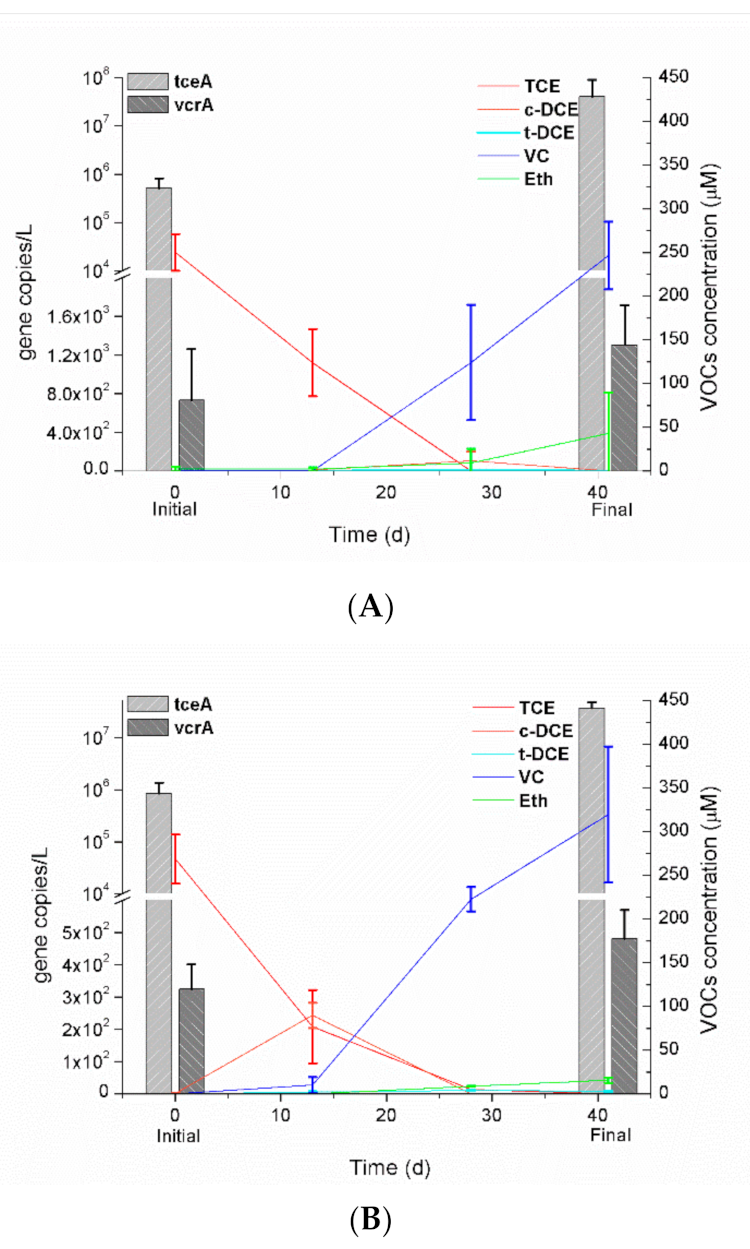
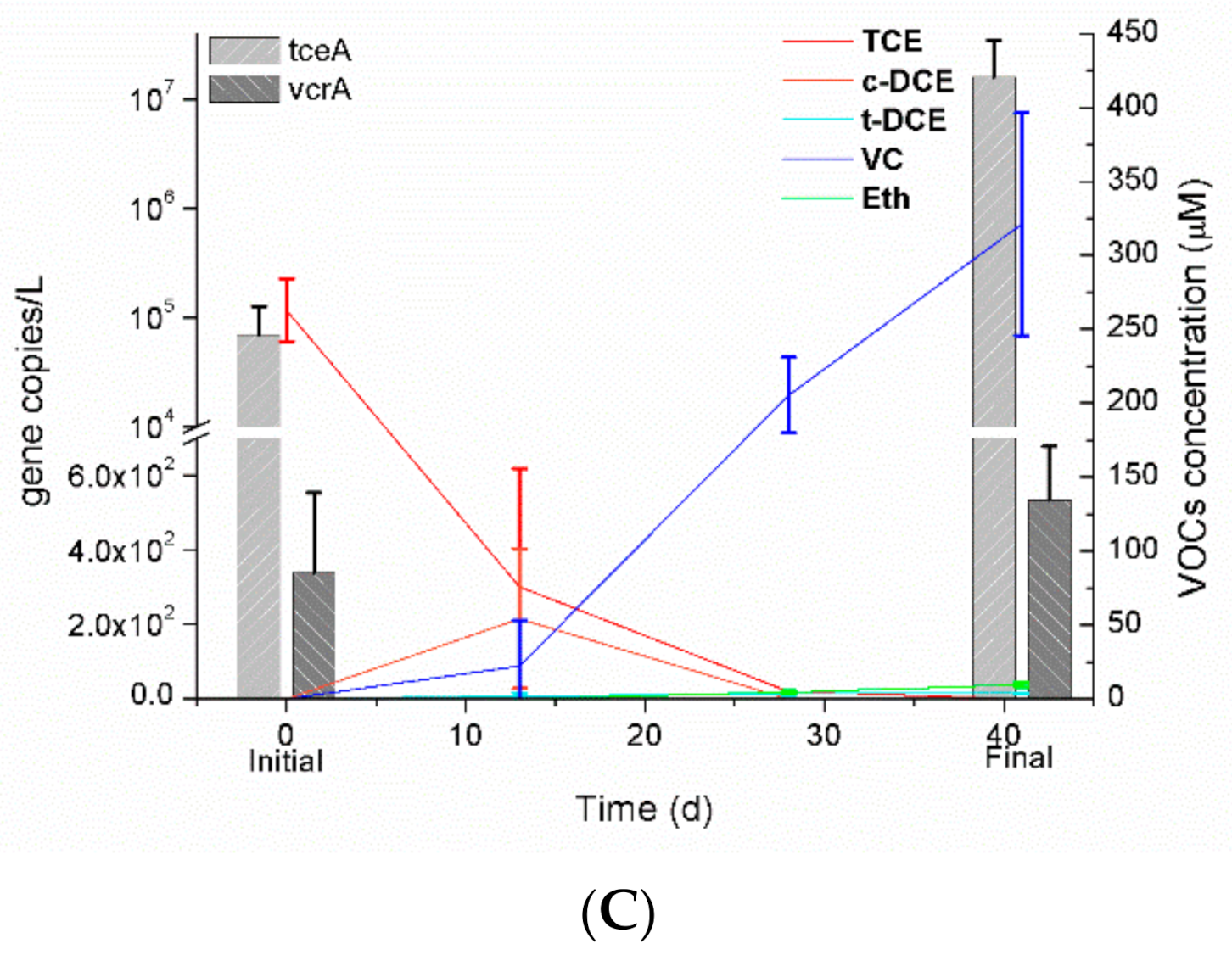
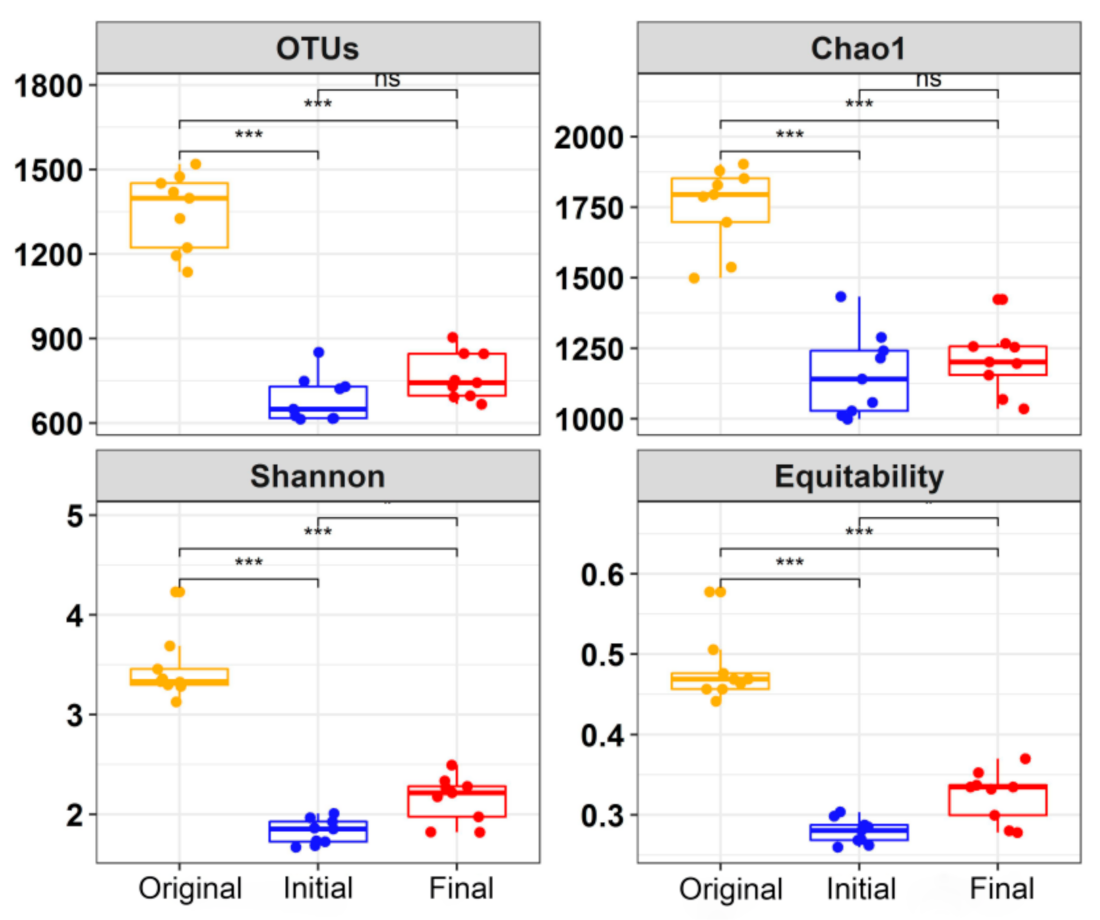
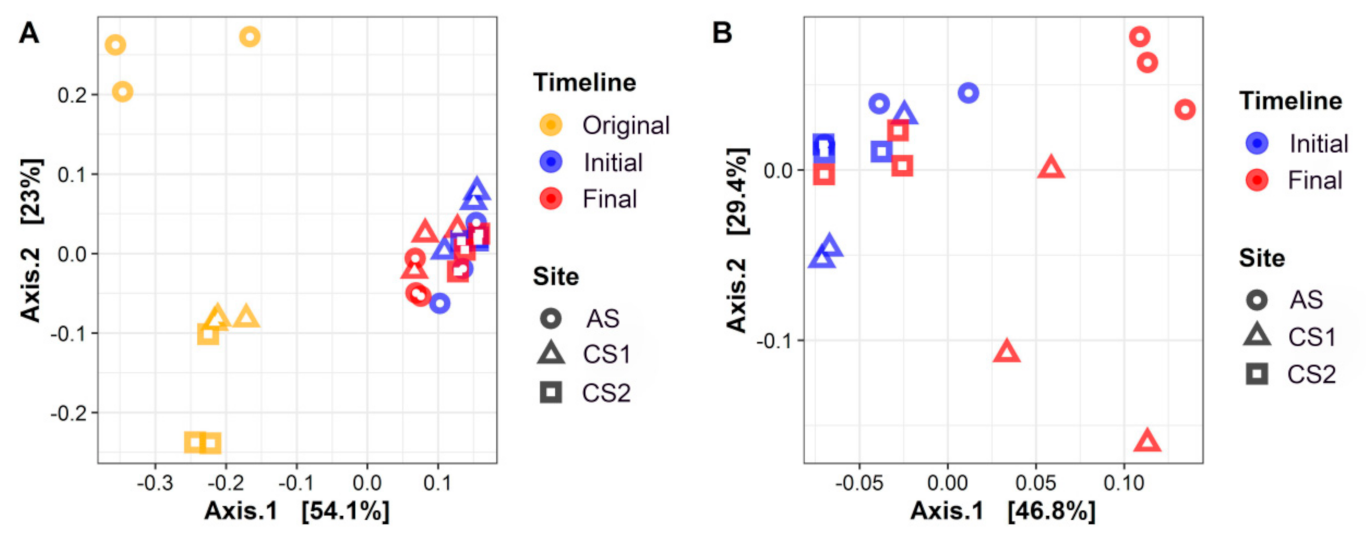
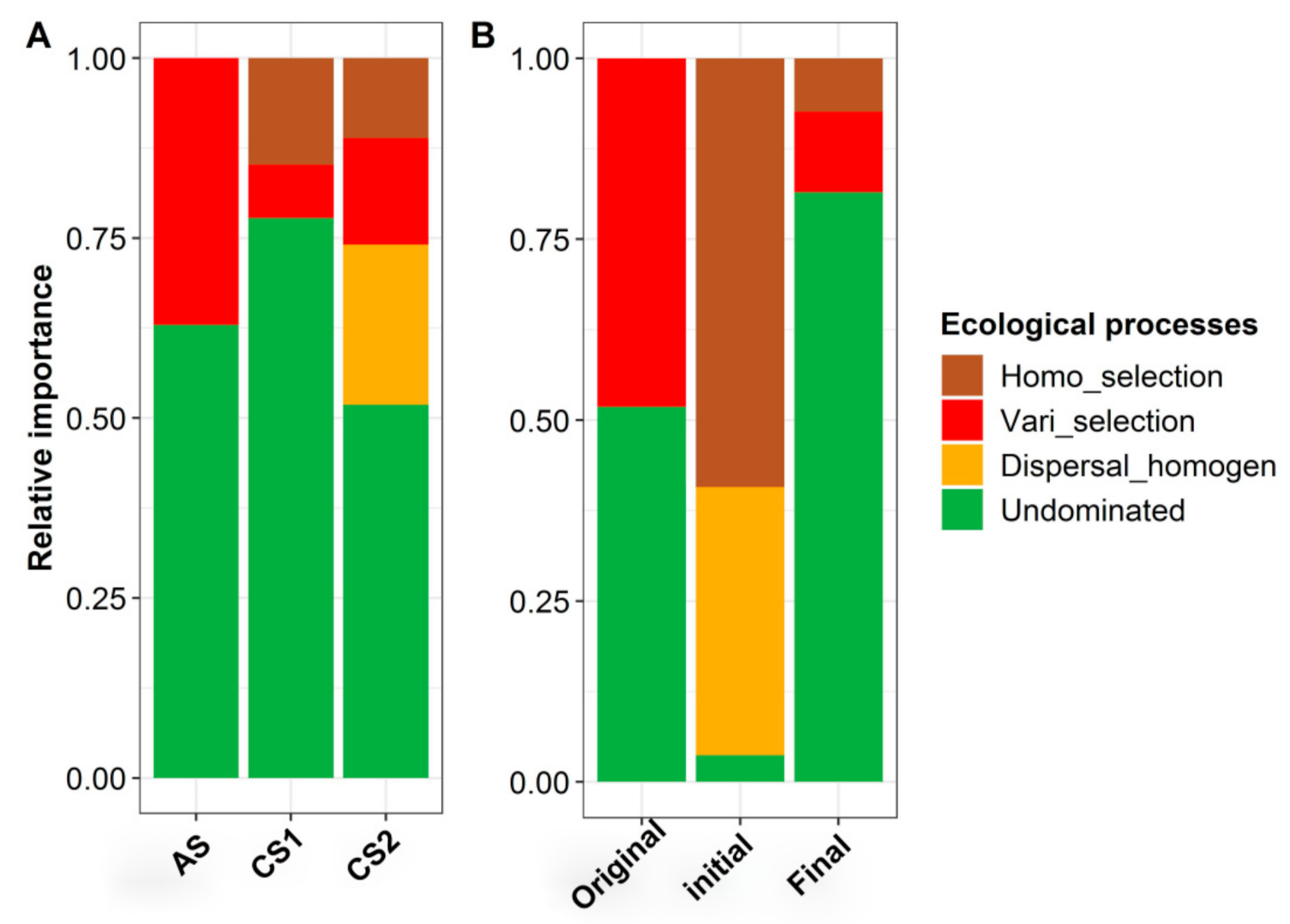

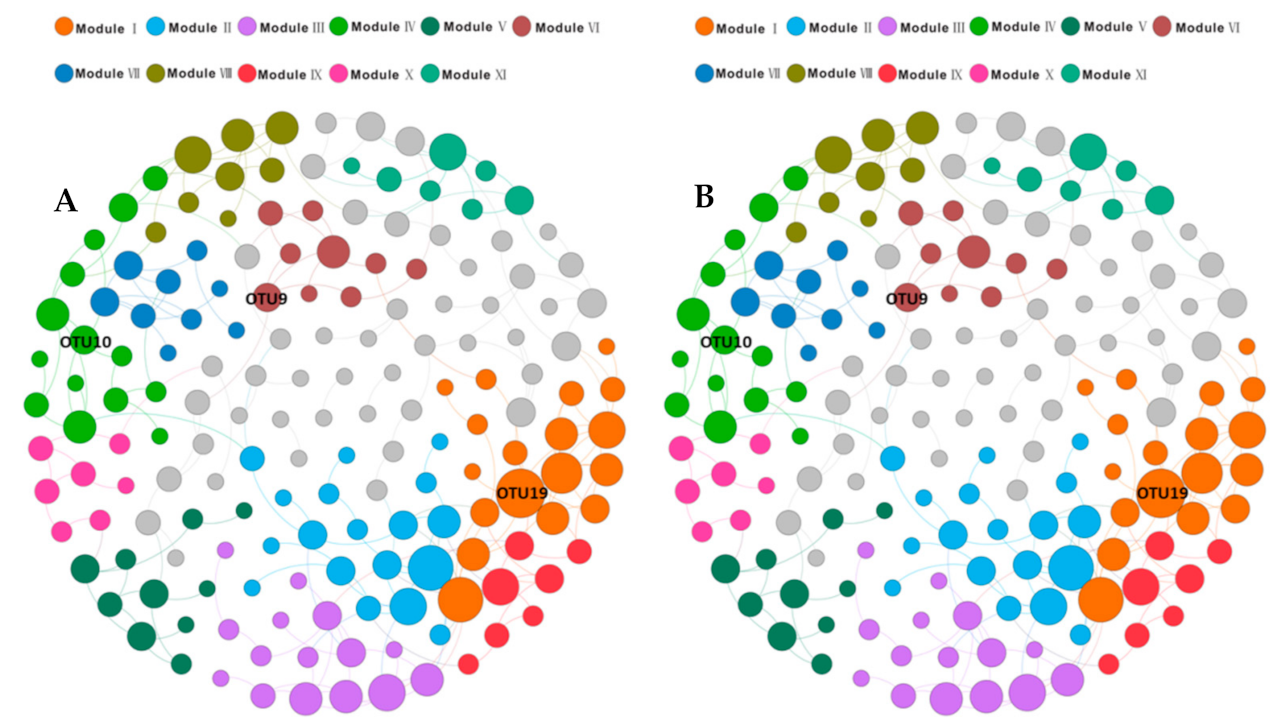
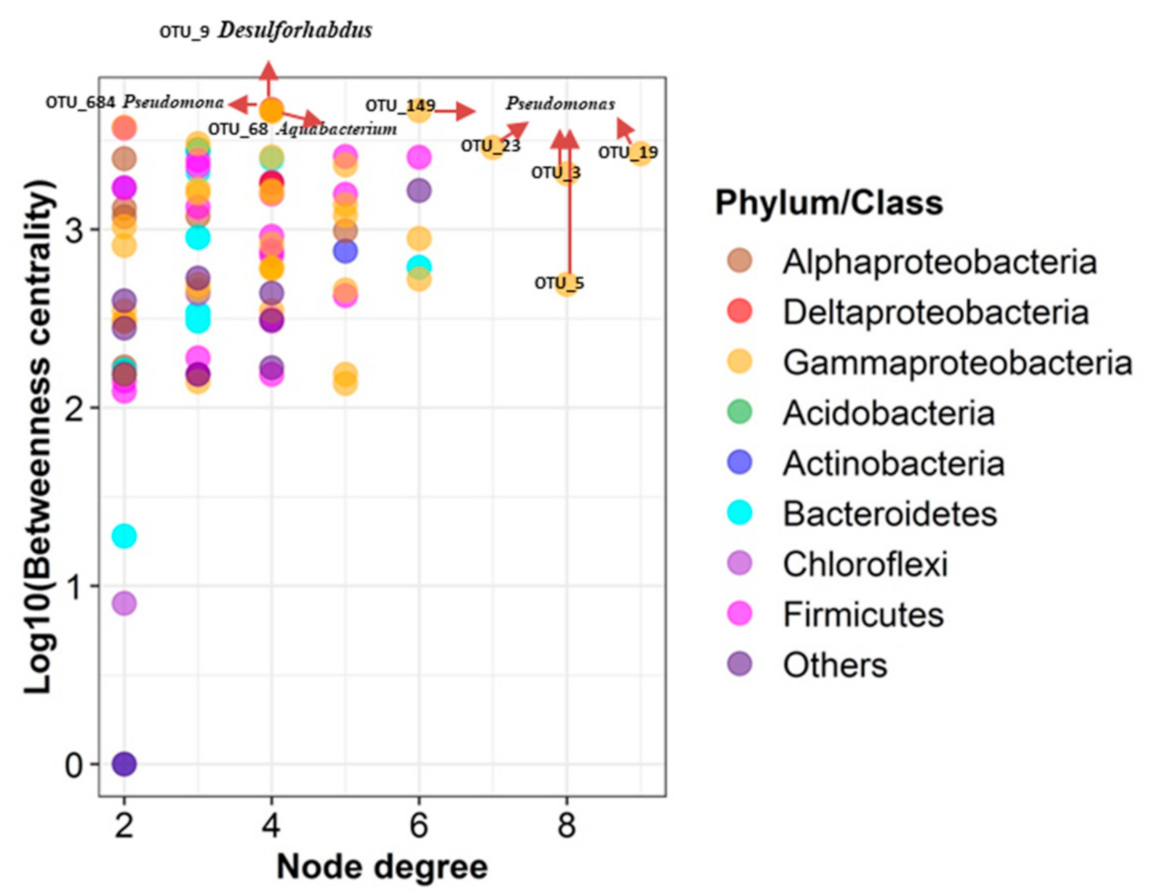
| Factor b | Adonis | ANOSIM | |||
|---|---|---|---|---|---|
| R2 | p | R | p | ||
| Whole a | Site | 0.082 | <0.01 | 0.028 | 0.214 |
| Time | 0.535 | <0.001 | 0.504 | <0.001 | |
| S * T | 0.228 | <0.001 | — | — | |
| Incubation | Site | 0.316 | <0.001 | 0.263 | <0.01 |
| Time | 0.223 | <0.001 | 0.235 | <0.01 | |
| S * T | 0.148 | <0.05 | — | — | |
Publisher’s Note: MDPI stays neutral with regard to jurisdictional claims in published maps and institutional affiliations. |
© 2021 by the authors. Licensee MDPI, Basel, Switzerland. This article is an open access article distributed under the terms and conditions of the Creative Commons Attribution (CC BY) license (https://creativecommons.org/licenses/by/4.0/).
Share and Cite
Li, J.; Hu, A.; Bai, S.; Yang, X.; Sun, Q.; Liao, X.; Yu, C.-P. Characterization and Performance of Lactate-Feeding Consortia for Reductive Dechlorination of Trichloroethene. Microorganisms 2021, 9, 751. https://doi.org/10.3390/microorganisms9040751
Li J, Hu A, Bai S, Yang X, Sun Q, Liao X, Yu C-P. Characterization and Performance of Lactate-Feeding Consortia for Reductive Dechlorination of Trichloroethene. Microorganisms. 2021; 9(4):751. https://doi.org/10.3390/microorganisms9040751
Chicago/Turabian StyleLi, Jiangwei, Anyi Hu, Shijie Bai, Xiaoyong Yang, Qian Sun, Xu Liao, and Chang-Ping Yu. 2021. "Characterization and Performance of Lactate-Feeding Consortia for Reductive Dechlorination of Trichloroethene" Microorganisms 9, no. 4: 751. https://doi.org/10.3390/microorganisms9040751
APA StyleLi, J., Hu, A., Bai, S., Yang, X., Sun, Q., Liao, X., & Yu, C.-P. (2021). Characterization and Performance of Lactate-Feeding Consortia for Reductive Dechlorination of Trichloroethene. Microorganisms, 9(4), 751. https://doi.org/10.3390/microorganisms9040751









